




Your support is critical to our success.
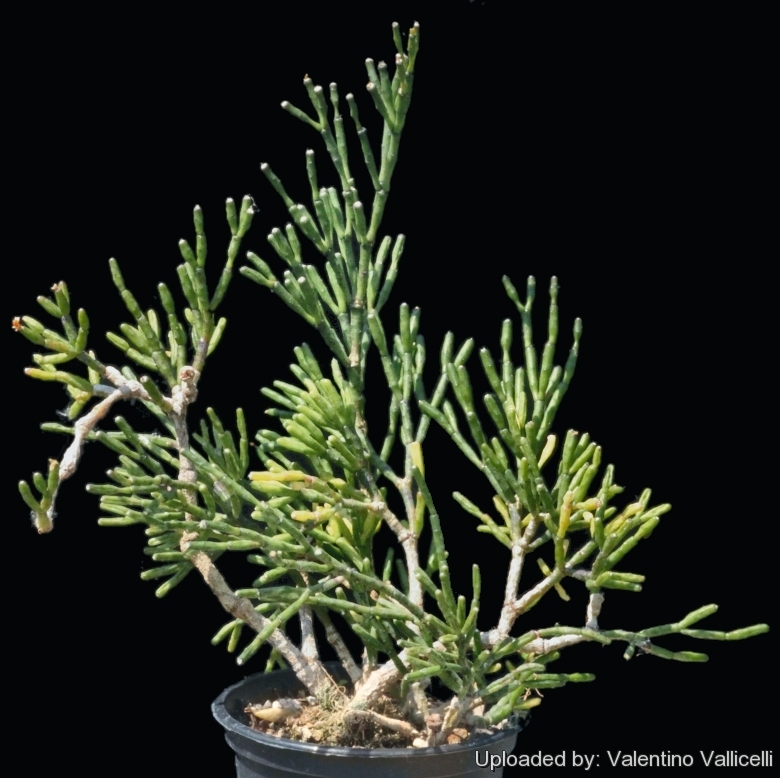
Origin and Habitat: Southeastern Brazil (Bahia, Minas Gerais, Espirito Santo, Rio de Janeiro, Sao Paulo, and Parana) and also reported as wild or naturalized elswhere. It has a wide range and, although it is not abundant, it is frequently encountered.
Altitude: Between 0 and 1850 meters over sea level.
Habitat: It is a rain-forest species that grows on trees as an epiphyte (or occasionally on rocks as a lithophytic). In other words, these are cacti that grow in trees! They grow their roots into the bark of their host tree. Their only access to moisture and nutrients is from rain and droppings that fall from above. They also always grow under a canopy of trees and are never exposed to the full sun of the desert.
Synonyms:
- Hatiora salicornioides Britton & Rose
- Cactus salicornioides (Haw.) Link & Otto
- Rhipsalis salicornioides Haw.
Hatiora salicornioides Britton & Rose
Stand. Cycl. Hort. 3: 1433 1915
Synonymy: 37
- Hatiora salicornioides Britton & Rose
- Cactus salicornioides (Haw.) Link & Otto
- Rhipsalis salicornioides Haw.
- Hatiora salicornioides f. bambusoides (F.A.C.Weber) Süpplie
- Hariota bambusoides F.A.C.Weber in Bois
- Hariota salicornioides var. bambusoides (F.A.C.Weber) K.Schum.
- Hatiora bambusoides (F.A.C.Weber) Britton & Rose
- Rhipsalis bambusoides F.A.C.Weber in Bois
- Rhipsalis salicornioides var. bambusoides F.A.C.Weber
- Hatiora salicornioides f. cylindrica (Britton & Rose) Süpplie
- Hatiora cylindrica Britton & Rose
- Rhipsalis salicornioides var. cylindrica (Britton & Rose) Kimnach
- Hatiora salicornioides f. gracilior (Salm-Dyck ex C.F.Först.)
- Hariota salicornioides var. gracilior (Salm-Dyck ex C.F.Först.) Gürke
- Hariota salicornioides f. gracilior (Salm-Dyck ex C.F.Först.) A.Cast.
- Rhipsalis salicornioides var. gracilior Salm-Dyck ex C.F.Först.
- Hatiora salicornioides f. gracilis (F.A.C.Weber) Süpplie
- Hariota gracilis F.A.C.Weber in Bois
- Hariota salicornioides var. gracilis (F.A.C.Weber) K.Schum.
- Hatiora salicornioides var. gracilis (F.A.C.Weber) Backeb.
- Rhipsalis gracilis F.A.C.Weber in Bois
- Rhipsalis salicornioides var. gracilis F.A.C.Weber in Bois
- Hatiora salicornioides f. stricta (F.A.C.Weber) Süpplie
- Hariota stricta (F.A.C.Weber) K.Schum.
- Hatiora salicornioides var. stricta (F.A.C.Weber) Backeb.
- Rhipsalis salicornioides var. stricta F.A.C.Weber in Bois
- Hatiora salicornioides f. strictior (C.F.Först.)
- Hariota salicornioides var. strictior (C.F.Först.) Gürke
- Hariota salicornioides f. strictior (C.F.Först.) A.Cast.
- Rhipsalis salicornioides var. strictior C.F.Först.
- Hatiora salicornioides f. villigera (K.Schum.) Süpplie
- Hariota salicornioides var. villigera (K.Schum.) Backeb.
- Hariota salicornioides f. villigera (K.Schum.) A.Cast.
- Hariota villigera K.Schum.
- Hatiora salicornioides var. villigera (K.Schum.) Backeb.
- Rhipsalis salicornioides var. villigera (K.Schum.) Loefgr.
- Rhipsalis villigera (K.Schum.) Orcutt
ENGLISH: Dancing bones, Spice Cactus, Bottle Cactus, Drunkard's Dream
LITHUANIAN (Lietuvių): Salikorninė hatiora
RUSSIAN (Русский): Хатиора солеросовая, Хатиора солеросовидная, Хатиора солянковидная
SWEDISH (Svenska): Glasörtskaktus
Description: Hatiora salicornioidesSN|22941]]SN|22941]] is a slender, erect, arching or somewhat pendent, bushy, cactus with unique jointed stems and many small yellow-orange flowers. It can be either epiphytic or terrestrial, but is commonly grown as a foliage plant. It has the common name of 'Drunkard's Dream' from the resemblance of the stem sections to bottles of beer. The plant is made of many-branched stems and reaches 30-60(-100) cm in height and spread. It is said that it deserves first place among the Cacti of easy culture.
Stems: Joined, becoming woody, very copiously branched. Branchlets (stem-segments) of strictly determinate growth, tiny, pale green to deep green, leaf-less and spineless (1,5-)2-3(-5) cm long, 3-4 mm in diameter, narrow, club-shaped, with a distinct basal neck and expanded tips, looking like an inverted bottle, arising in whorls of two to six from tops of older ones and growing upright for some time before sprawling under their own weight.
Areole: Joints have a large woolly composite areole with short bristles at tips of branches from which the flowers and succeeding cladodes arise, the minuscle white spots visible on these stems are, technically, typical cactus areoles minus the spines.
Spines: Usually absent, but rarely produced, sometimes towards the base of relatively old stems or, in atavistic fashion, on isolated stem segments.
Flowers: Always terminal at tips of younger stem segments, small, bell-shaped orange yellow or light salmon, 1-2 cm long and in diameter.
Blooming season: Late winter to early spring.
Fruits: White, translucent, top shaped berries.
Remarks: Hatiora salicornioidesSN|22941]]SN|22941]] is extremely variable and probably deserves subdivision into infraspecific taxa.
Chromosome number: Hatiora salicornioidesSN|22941]]SN|22941]] is a diploid species with a chromosome number of 2n = 2x = 22 .
Notes: The specific epithet, "salicornioides" is a reference to the genus Salicornia (Chenopodiaceae) which also has well-marked segmentation of stems. Hatiora differs from Rhipsalis in the stem-segments having very unequal distal and proximal ends and flowers in a pseudoterminal position, rather than lateral.
Bibliography: Major references and further lectures
1) Edward Anderson “The Cactus family” Timber Press, Incorporated, 2001
2) James Cullen, Sabina G. Knees, H. Suzanne Cubey "The European Garden Flora Flowering Plants: A Manual for the Identification of Plants Cultivated in Europe, Both Out-of-Doors and Under Glass" Cambridge University Press, 11/Aug/2011
3) David R Hunt; Nigel P Taylor; Graham Charles; International Cactaceae Systematics Group. "The New Cactus Lexicon" dh books, 2006
4) Neil Owen Anderson “Flower Breeding and Genetics: Issues, Challenges and Opportunities for the 21st Century” Springer Science & Business Media, 01/Oct/2007
5) Hans Hecht "Cacti & succulents"Sterling Pub. Co., 1997
6) Philip Perl "cacti and succulents" 1978
7) Elvin McDonald "The New Houseplant: Bringing the Garden Indoors" Macmillan General Reference, 01/apr/1993
8) Urs Eggli, Leonard E. Newton "Etymological Dictionary of Succulent Plant Names" Springer, Berlin/Heidelberg 2010
9) Taylor, N.P. & Zappi, D. 2013. Hatiora salicornioides. In: IUCN 2013. "IUCN Red List of Threatened Species." Version 2013.1. <www.iucnredlist.org>. Downloaded on 02 November 2013.
10) Forest & Kim Starr Hatiora salicornioides (drunkard's dream, spice cactus). Plants of Hawaii. <http://www.starrenvironmental.com>. Downloaded on 22 August 2014.
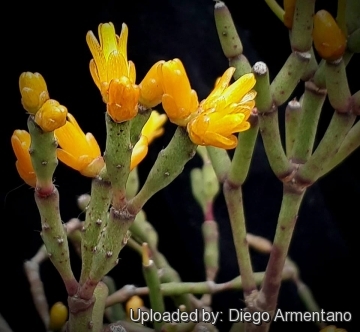
Hatiora salicornioides Photo by: Diego Armentano
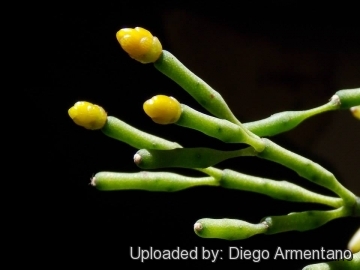
Hatiora salicornioides Photo by: Diego Armentano
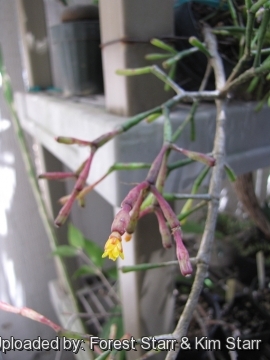
Flowers at Ulana St Makawao, Maui; Hawaii (USA). April 11, 2010. Photo by: Forest Starr & Kim Starr
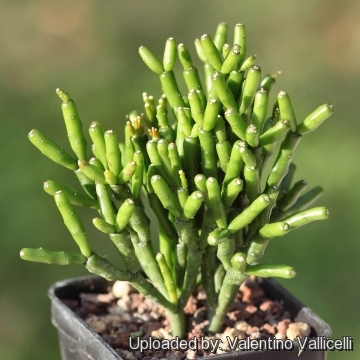
Hatiora salicornioides Photo by: Valentino Vallicelli
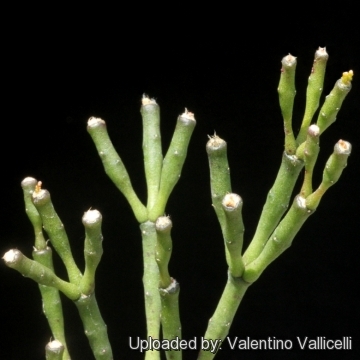
Hatiora salicornioides Photo by: Valentino Vallicelli
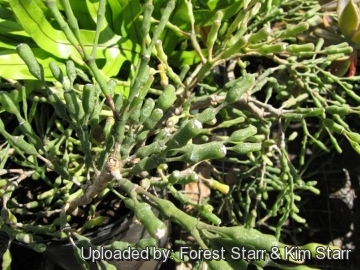
Habit at Kihei, Maui, Hawaii (USA). February 15, 2011. Photo by: Forest Starr & Kim Starr
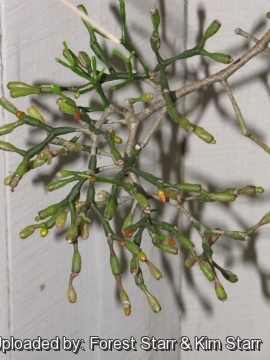
Flowering habit at Ulana St Makawao, Maui, Hawaii (USA). February 18, 2011. Photo by: Forest Starr & Kim Starr
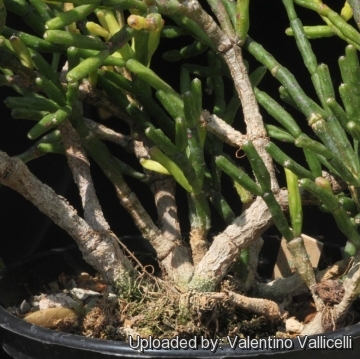
Hatiora salicornioides Photo by: Valentino Vallicelli
Cultivation and Propagation: Hatiora salicornioidesSN|22941]]SN|22941]] appreciate more organic matter in potting mixes than most terrestrial cacti
And do best in soils containing sphagnum. This type of soil would normally be used for orchids, bromeliads or other epiphytic plants. They require ample summer water and partial shade, but allow soil to dry slightly between waterings; During the flowering cycle keep them moist (but not soggy). After the blossoms have fallen off you should back off on the water for a couple of months. If they need repotting, this is the time to do it. They drop their buds easily if they are moved. Once flower buds have formed, DO NOT MOVE the plant, as slight changes in environment may cause the buds to drop. These forest cacti tend to be long lived.
Propagation: Stem cuttings, Grafting (For grafting this plant Acanthocereus pentagonusSN|4326]]SN|4326]] is a good stock)
| Your Actions | |
|---|---|
| Back to Hatiora index | |
| Back to Cactaceae index | |
 |
Back to Cacti Encyclopedia index |
Privacy stantement - Terms and conditions - How to cite - About us - Feedback - Donate




